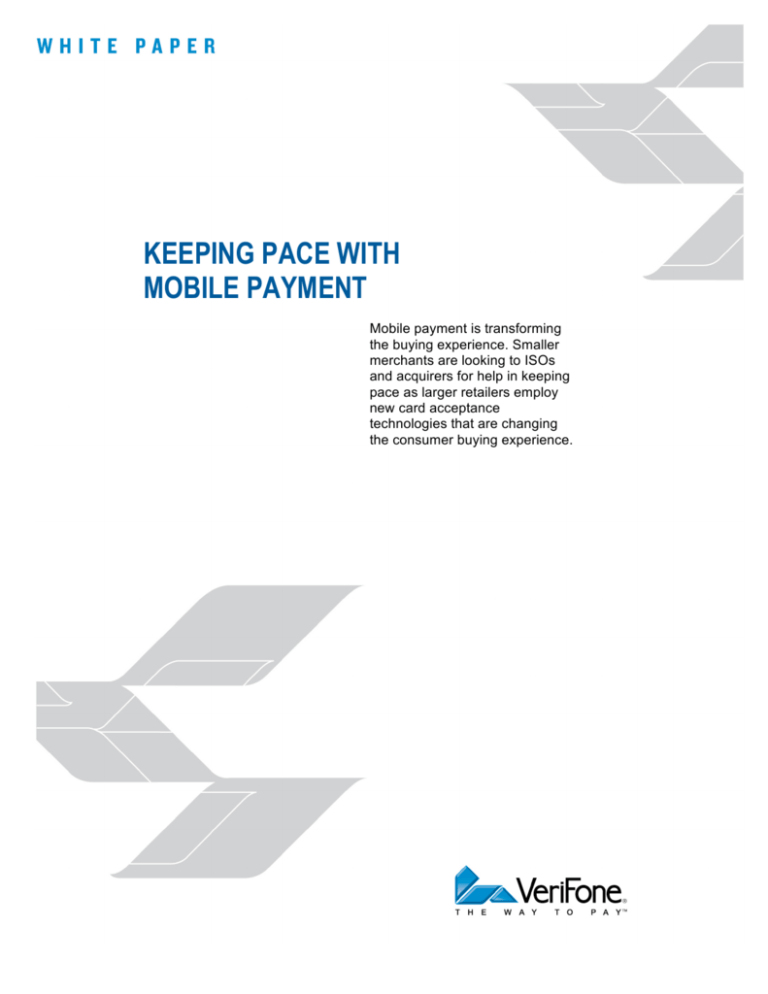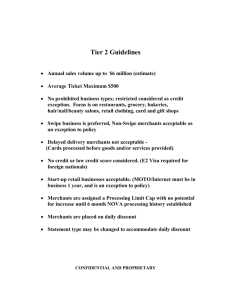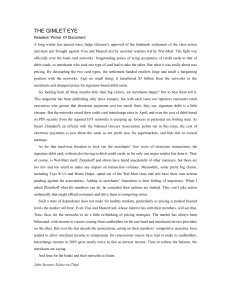
KEEPING PACE WITH
MOBILE PAYMENT
Mobile payment is transforming
the buying experience. Smaller
merchants are looking to ISOs
and acquirers for help in keeping
pace as larger retailers employ
new card acceptance
technologies that are changing
the consumer buying experience.
EXECUTIVE SUMMARY
Hyped far beyond reasonable expectations, mobile payment is still in the formative stage. Many
service providers, banks, handset manufacturers and new startup companies pursue divergent
strategies. The result: fragmented approaches and shifting alliances that can cause confusion and
skepticism. We’ve been there before—with the PC and “cellular” phone, but today life without either
is unimaginable. Mobile payment is following a similar path. This white paper examines the basic
issues impacting adoption of mobile payment and what merchants, acquirers and ISOs need to
know to prepare for the improvement to the customer experience that well-executed mobile
payment strategy can bring.
KEEPING PACE WITH MOBILE PAYMENT
2
AUGUST/2013
CONTENT
Executive Summary
2
Fast-changing Consumer Behavior
4
Merchants Sort Through Landscape Confusion
5
The Two Sides of Mobile Payment
6
Technology Options: From mPayment to mPOS
8
The First Step
9
KEEPING PACE WITH MOBILE PAYMENT
3
AUGUST/2013
FAST-CHANGING CONSUMER BEHAVIOR
By the end of May 2013, more than 141 million people in the U.S. owned smartphones, according
to one market research firm1. With ready access to online browsing, consumers are able to
compare prices from online and nearby stores, gaining an advantage over the merchant.
Furthermore, they increasingly expect merchants to accommodate smartphones with a variety of
applications such as mobile payment, loyalty applications, local ‘check-in’ and coupon
redemptions.
These shopper aspirations are being stoked by the promises of various digital wallet schemes
including PayPal, Google Wallet, and the Isis venture backed by major wireless carriers. These
efforts have suffered from industry hype and unrealistic expectations but some now appear to be
gaining traction as large-scale rollouts begin.
Nonetheless, you only have to walk into a Starbucks and observe the frequent use of the
Starbucks Card Mobile App to realize that consumer behavior is changing due to mobile
technology—company executives disclosed in July 2013 that 10 percent of all payments in U.S.
stores are made with mobile phones. An April 2013 report from Google concluded that 79 percent
of smartphone owners are “smartphone shoppers” who regularly use their mobile device to assist
in their shopping efforts. Furthermore, 82 percent of those smartphone shoppers use search
engines for browsing product information while in the store.
As consumers become more adept with mobile technologies, it’s only natural that they expect
merchants, large or small, to accommodate their mobile devices, whether for payment or other
applications that enrich the shopping experience. To keep pace with these changing consumer
expectations, even smaller businesses need to develop a mobile strategy to engage with
consumers and improve the shopping experience, or risk losing valuable shoppers to competitors
who are more accommodating.
KEEPING PACE WITH MOBILE PAYMENT
4
AUGUST/2013
MERCHANTS SORT THROUGH LANDSCAPE
CONFUSION
Traditional smaller merchants may still be wondering what all the fuss is about. The hype behind
many mobile payment initiatives seems to often leave reality in the dust. Google Wallet, for
example, launched to great fanfare in early 2011, but has only gained limited traction in the large
retail market, let alone staking out any footprint in the typical ‘Mom & Pop’ convenience store or dry
cleaner. Similarly, Isis, the mobile payment venture launched by AT&T Mobility, T-Mobile USA and
Verizon Wireless has only recently announced a national rollout.
Nonetheless, the major card brands in the U.S. have attempted to tie the optional adoption of NFC
to the EMV transition. Through the use of incentives they hope to quickly entice merchants to
implement NFC-ready payment devices. The EMV liability shift essentially pushes the cost of card
fraud to the least secure link in the payment chain, so if an acquirer is EMV compliant but a retailer
isn’t, the retailer will end up absorbing the cost of card-present counterfeit fraud for a card payment
that could have been prevented using an EMV device. Although NFC does not follow that same
path, they hope merchants will implement NFC and EMV in parallel.
Larger retailers with deep pockets are readying for the EMV/NFC era of mobile payments,
deploying NFC-ready devices and implementing mobile POS systems and other mobile
applications to expand their reach beyond the countertop and find new ways to enrich the shopping
experience. Small to medium-sized merchants may lack the resources to develop custom apps, but
as consumers increasingly learn how to use mobile payment and related applications, they’ll begin
to expect to be able to do so in even the smallest shop.
Many independent businesses previously without payment systems, have quickly embraced the
concept of smartphone adapters and apps that make it easy to swipe a card and get paid
electronically. Many such payment services are available today, mainly selling the promise of a
simple one-fee-fits-all cost structure. That type of service is fine for small volume merchants, but
stores that handle a regular flow of card-based purchases understand that type of fee structure can
be relatively expensive.
All in all, for the merchant it adds up to a confusing and perplexing environment. They know
consumers are not going to give up their mobile devices to make a payment. What they need help
with is understanding the options available to help them accommodate the mobile shopper and
avoid making costly errors in their decision-making.
KEEPING PACE WITH MOBILE PAYMENT
5
AUGUST/2013
THE TWO SIDES OF MOBILE PAYMENT
No matter what mobile device, digital wallet or app that consumers carry, they still must interact
with and authenticate their cards securely at a merchant point-of-sale system. And all new payment
options and value-added services must integrate smoothly at the point of sale with existing card
schemes, couponing and loyalty systems or merchants will reject it.
Mobile payments are often mistakenly lumped under one umbrella, but from the merchant’s
perspective there are two quite distinct implementations:
•
First is the acceptance of a consumer’s mobile payment, which can be done either with a
specially equipped smartphone, tablet or other device, or with traditional dedicated
countertop or handheld payment terminals that feature mobile acceptance built in.
•
The second implementation involves mobilizing the merchant, so that he or she can bring
payment and other applications to the shopper, whether somewhere in the aisles of a store
or in a home, office, sports stadium or at a sidewalk sale.
Ensuring Acceptance
NFC-enabled mobile phones use the same ISO 14443 standard currently used by contactless
credit and debit cards, so for payment only, the phones are compatible with contactless technology
already deployed in many locations and available as a standard feature in new payment terminals
from VeriFone. The phones use a smart chip “secure element” to store the payment application
and consumer account information. VeriFone’s more traditional line of dedicated countertop and
handheld payment terminals accept a wide variety of card payment options including NFC, mobile
wallets, EMV, and contactless payments. All of VeriFone’s NFC-enabled devices come with a
flexible NFC App Manager built-in that allows new NFC or cloud wallet acceptance apps to be
easily added, updated or removed without affecting other apps. Payment apps are further
firewalled from value-added apps to ensure absolute security on payment transactions.
KEEPING PACE WITH MOBILE PAYMENT
6
AUGUST/2013
Mobilizing the Merchant
The other facet of mobile payments provides the merchant with even greater opportunity to transform the
shopping experience. Mobile payment technology provides a new level of consumer interaction that
empowers a merchant to accelerate sales, elevate service and boost revenues. With mobile devices in
hand, the merchant can more readily engage with customers to provide convenience, speedy payment in
the aisles or outside the store, and new shopping experiences.
With more consumers than ever relying on the convenience of debit and credit cards, any merchant that is
unable to accept payment away from the countertop - whether in the aisle or outside the store - is at a
competitive disadvantage. Consumers quickly learn where their shopping needs are matched by a
merchant’s ability to best meet those needs.
Small to medium-sized merchants, though, are understandably hesitant to invest in new technology in
such unsettled times for fear of being locked into inflexible solutions. Yet if they are unable to keep up with
these changes, these merchants risk losing customers who expect to be offered the latest options and
conveniences.
Tablets, and smartphones equipped with card scanners and apps provide an easy to adopt solution for
mobilizing the payment transaction. Many smaller merchants already own or plan to buy these types of
devices for other business functions (calendar, email, etc.) so the addition of payment functionality
provides them with a convenient, multifunction alternative to traditional dedicated payment terminals.
KEEPING PACE WITH MOBILE PAYMENT
7
AUGUST/2013
TECHNOLOGY OPTIONS: FROM MPAYMENT TO MPOS
For many merchants, mobilization of payment acceptance opens up new possibilities for efficiency,
increased profitability, and customer satisfaction. Line-busting—pulling shoppers out of slow
checkout lines to complete payment on a mobile device—allows store owners and employees to cut
down on lost sales due to shoppers losing patience over wait times.
Mobile payment acceptance also makes it possible for merchants to go beyond the four walls of a
store front location to create new sales opportunities such as sidewalk sales, events at sport
stadiums and flea market sales, or home and office deliveries. For businesses that are mobile by
nature, the mobile payment acceptance frees them from the limitations of cash-only sales and the
inconvenience and risk of paper checks.
Merchants can be prepared for virtually any handheld POS need. In addition to processing
transactions quickly, they can opt to send digital receipts to customers email addresses—extending
their brand and winning increased customer loyalty. Additionally, sophisticated reports and
convenient web-based dashboards can provide easy and up-to-date insight into sales activity
across multiple payment devices.
In addition to payment, merchants are finding new opportunities to increase sales and give their
customers a custom, personalized shopping experience usually associated with high-end chains,
which builds brand loyalty. With a mobile POS solution, merchants can bring the full power of the
fixed point-of-sale register into the aisle to freely engage with customers anywhere and take
advantage of features such as inventory lookup.
KEEPING PACE WITH MOBILE PAYMENT
8
AUGUST/2013
THE FIRST STEP
As merchants ponder mobile payment options, consumers have raced ahead in the adoption of
new applications and capabilities made possible by smartphones and other connected devices.
The power and convenience of mobile payment can transform the in-store shopping experience but
it is up to merchants and their service providers to adapt to this new era. The promise of mobile
payments and related applications is too great to ignore and those who do so risk losing customer
loyalty to more adaptive competitors. Mobile payments are just the start: value-added applications
such as mobile offers, couponing, loyalty and other mobile-commerce applications will create new
opportunities for both merchants and consumers. Mobile payment is the first step.
1
comScore, Inc., June 28, 2013, “comScore Reports May 2013 U.S. Smartphone Subscriber Market Share.”
http://www.comscore.com/Insights/Press_Releases/2013/6/comScore_Reports_May_2013_U.S._Smartpho
ne_Subscriber_Market_Share
©2013 VeriFone. All rights reserved. No portion of this document may be reproduced or distributed in any form or by any means without
the prior written permission of said company. All trademarks are the property of their respective owners.
NA_NAFG_Mobility_White_Paper_082313
KEEPING PACE WITH MOBILE PAYMENT
9
AUGUST/2013







